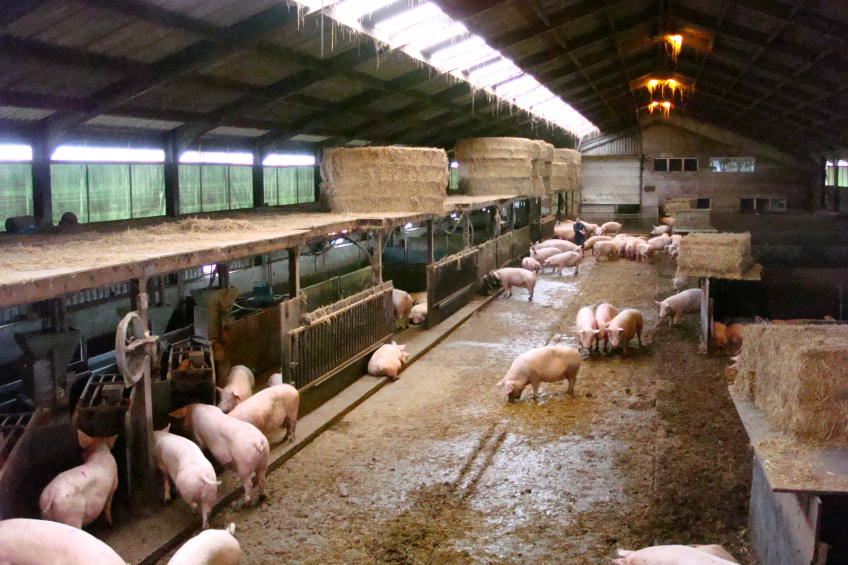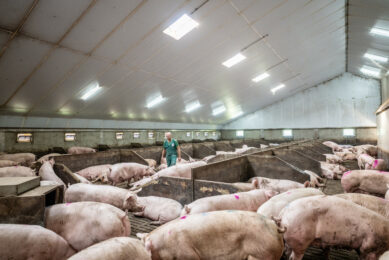550 sows in one big group

It’s a rare sight – 550 pink bodies lying peacefully on straw. Maarten Rooijakkers, pig producer in the south of the Netherlands, keeps his gestating sows in one large group. Correct feeding, selection, heat detection and vaccination is all dependent on identification technology.
By Vincent ter Beek
Looking out on 550 pink bodies, lying peacefully on straw, Arno van Brandenburg, product manager at Nedap Velos, almost turns philosophical. “The biggest problem about running a pig farm like this way is not related to the management. It’s the producer. He needs to adapt his mentality.”
Maarten Rooijakkers: “You should take into account that sows sometimes have a bad day.”
Maarten Rooijakkers, 47, can agree with that. “I know quite a lot of colleagues who are keen on controlling most of the production process. They’d like to see that all sows get fed properly. They’d like to make sure all animals are healthy. They’d like to guide the new gilts to the feeding machine. Well – not me. I hardly see my sows. I just look down on the sow house from my office.”
Van Brandenburg adds, “Sometimes, people themselves can have a bad day as well. Not having dinner is not a big disaster if it happens once.”
Rooijakkers’ 70 x 20 m sow house is one of the few in the Netherlands attracting visitor numbers – around 6,000 on a yearly basis. All members of the public are welcome to have a look and learn what’s going on in a pig house by entering a special cabin next to the pig house, which allows visitors to observe the animals through a
window. Rooijakkers stares through one of these windows while telling more about his pride.
“The funniest thing of this sow house is that most visitors actually believe its ecological pig farming. Most people do not see it’s actually conventional pig farming – using a lot of technology.”
Even before the European Union ruled that 2013 will be the year in which all sow stalls should be eradicated, Rooijakkers realised that with loose sow housing his farm would be future-proof. In 1999, he and his brother John decided to move away from their mixed facility with dairy cows, breeding pigs and fatteners – and focus only on having sows for breeding. The pair informed themselves properly and eventually decided to go for electronic sow feeding stations as a management system.
Hierarchy
Where most producers would decide to split up their herd in several smaller groups, Rooijakkers was convinced to try otherwise. “Sows usually start fighting for hierarchy reasons. However, when groups are larger than, say 200 sows, this stops. So once groups are large enough for the pigs to live in, the fighting simply stops.” The reason behind this behaviour largely comes down to space matters. Dominant sows can easily be avoided by lying down somewhere else.
Initially, Rooijakkers had his group divided into two groups, one with gilts and younger sows, and one with older sows. This however proved to be suboptimal, since the feeding stations in each sections were placed in opposite directions. Once younger sows were ‘promoted’ to the other half, they sometimes had difficulty getting used to the different lay-out of the feeding station. Hence, Rooijakkers decided to take out the separation between the groups. The sows could now choose where to dine – and thus had freedom to get used to whatever entrance they preferred. “Ever since, things have worked fine,” he says. Only for the youngest gilts, a small training area has been created.
In a sow house with these dimensions, identification is key – and this happens through ten Electronic Sow Feeding stations with subsequent separating sluices, provided by Dutch manufacturer Nedap Velos. “We may see one group here, when looking out of the window,” Rooijakkers explains, “but the computer sees nine. There are nine different feeding regimes, depending on the animal’s phase during gestation. Inside the sow feeding sluice, two compound feeds are provided. The animals get a fair share of both – but the exact mixture depends on their phase in gestation.”
In theory, all sows will have to pass the feeding station once a day – which starts at 11am. Dominant sows will feed themselves first, for the rest of the animals the remainder of the day is sufficient. Entering data in the computer management system allows Rooijakkers to separate on several criteria, be it automatic heat detection by the computer, vaccinating purposes, farrowing – or simply transponder loss.
Adjacent to the sow house is a farrowing house, having 210 farrowing crates. In the 55 insemination stalls, the sows usually stay there about one week, van Brandenburg explains. “Sows are going in group housing approximately two to three days after insemination, with extremely good results.”
The pigs are finished in three different fattening places in the area, of which Rooijakkers owns two. He has plans of building a third finishing place, thus effectively taking pig finishing into his own hands again. After processing, the meat is sold to British supermarket chain Tesco, which is convenient as this retailer requires the use of loose sow housing in the production process. This UK connection also implies that Rooijakkers does not castrate male piglets, which is rather unique for the Netherlands.
Straw
Having his sows in one big group yields positive results Rooijakkers feels, with 31.2 weaned piglets/sow/year. The work is rather labour extensive as the only thing that needs to happen is manure cleaning in the main corridor. This can be easily done by using a shovel each morning, which enters through a large entrance on the side – cleaning takes about 30-45 minutes. Cleaning out the beds is not necessary.
Adding new straw is another daily job – it can be simply added on top of the existing straw beds, which keeps their places warm and comfortable. And this, Rooijakkers knows by experience, doesn’t have to cost too much. He uses 240 kg straw/sow/year, which equals to one new heap of 330 kg per day for the whole of the sow house. Total daily costs: €33.
Technical data – Rooijakkers Farm, 2008
• Total number of sows: 760
• Fattening farms: 4 (1 under construction)
• Produced piglets/year: 22,000-23,000
• Liveborn piglets/litter: 13.6
• Deadborn piglets/litter: 0.7
• Farrowing mortality: 8%
• Growing mortality: 1.2%
• Litters/year: 2.45
• Piglet ADG/day: 310 g
• Re-insemination: 9%
• Weaned/sow/year: 31.2
• Parities/sow: 3.6-3.7
• Vaccinations: parvovirus
• Slaughterweight
– Boars: liveweight: 110 kg; dead weight: 75-90 kg
– Gilts: liveweight: 120 kg; dead weight: 85-104 kg
For more pictures, turn to VOF Rooijakkers Photo gallery
Source: Pig Progress Volume 25 nr 4











